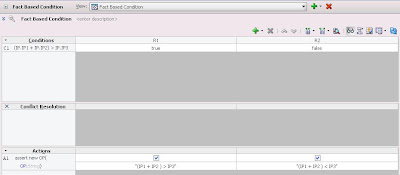In Oracle Business Rules, it is usually the practice to validate a fact against a constant. But there might be cases where you would want to map the input from an user to one of fact, compare another fact with input from the user and make decisions. In other words, when the value of the constant to be issued in the condition is itself ambiguous, it is better to use the facts vs facts instead of facts vs constant method. For instance, I have a case where I have three inputs IP1, IP2 and IP3 coming in and I do not want to fix values (use constants for comparison in condition of rules) and instead make a condition directly involving IP1, IP2 and IP3. My schema in such a case will look like:
The decision table involving the facts will look like below:
The facts have been directly compared against each other without the need for a constant.
Peace!
Cheers,
- AR
Stef’s Monthly Update – November 2017
-
Another month has gone by, and I am a bit late with my story. November was
another busy month after October with Integrate and other things. Month
Novemb...
8 years ago




